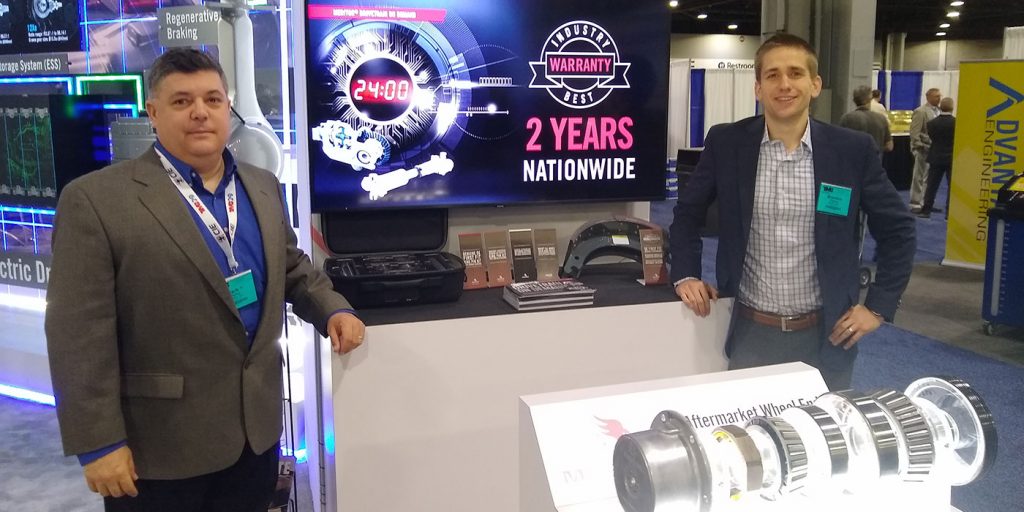Push a button, get what we want. That’s our expectation as consumers, and we bring that expectation to work with us. This is especially true in the heavy-duty aftermarket, where you need parts now to get your truck back on the road. Meritor’s Joe Palmer, director of fleet sales, and Mark Holley, product line director, saw that the heavy-duty service market was hungry for hard parts and found a way to deliver them now with the Drivetrain On Demand program, a portfolio of more than 10,000 driveshaft and differential assembly part numbers shipped within 24 hours and sporting a two-year nationwide warranty.
I sat down with Palmer and Holley at the 2020 TMC Annual Meeting and Exhibition to dig into the program’s details and how they brought it to the market.
Holley: Drivetrain On Demand is basically a service that we’re providing for quick turnaround on driveshafts orders, as well as our Reman differentials. Of course, we’ve been offering these products in the market for many years, but with this program, we’re able to custom build and ship products within 24 hours utilizing genuine components.
FE: Nationwide?
Holley: Nationwide, covered under a two-year warranty with unlimited miles. No matter where the requirement is within the continental United States or Canada, we provide the coverage.
FE: Can you give me an idea for how prevalent Drivetrain service events are out there on the road?
Palmer: So, it’s an interesting question. In my fleet group, it’s the fleets that are using their trucks over a long lifecycle. If a customer is buying a truck, and they only hold it for the first five years of vehicle’s life cycle our products usually don’t have any issues during that time.
Fleets with longer lifecycles that typically keep their tractors beyond the warranty period, have a higher probability of seeing normal wear and tear failures. When that happens, we wanted to provide a quick solution for them to be able to get them back up and running. It’s not a prevalent issue across our product portfolio, but it does happen after some point given certain driving conditions. If you’re a fleet that has thousands of assets, you’re going to have it happen, and when it does, your truck is down. It means you’re not going anywhere. That’s been the major emphasis and why we have designed this program.
FE: What about application? Do you see more issues in off-road or construction type vocations?
Palmer: I think it’s much more prevalent in those types of situations where fleets are pushing their equipment to the max, whether it’s off-highway or on-highway fleets maximizing their utilization.
Holley: We see failures in both on-road line-haul and vocational applications. The line-haul applications are higher in number and accumulate more mileage per day. The vocational fleets see higher loads. In addition to this, weather conditions where these fleets operate can also be a determining factor if the trucks are operating in the ice and snow.
Palmer: When we originally launched this, and we had the big emphasis on driveshafts. We’ve broadened it out to include the differential side of it. Depending on what differential the customer might have on some of these older assets, they had the lubing system mechanism inside with the gears. It wasn’t as sophisticated. So some of those spin-out issues could cause the differential to overheat, and then it could have higher failure rates if the driver didn’t necessarily drive correctly. A lot of that has been engineered heavily out to a larger extent with today’s products.
FE: What work went in behind the scenes to make the 24-hour turnaround a reality?
Palmer: Part of what we wanted to build out was our network of Authorized Rebuilders. We went out and looked at Rebuilders across the United States and Canada. We looked for folks that had the right type of a shop, ran a good business, and ones that we should go in and inspect. We then worked with them to ensure their processes were up to our standards and ultimately be able to turn around a unit within 24 hours.
Holley: It was a massive undertaking, but we now have 65 locations across the U.S. and Canada, ensuring the success of this program and maximizing the fleets’ uptime.
Palmer: We’ve got a full system solution that can service both Meritor and competitors’ platforms.
What Meritor is doing right now is getting the right part to the right place, at the right time. It’s demystifying a lot of those elements around getting the right part to the service location. Sometimes a service location will get the part in and it’s the wrong part because the person couldn’t identify it correctly. We’ve put in a lot of resources into our website, Meritor Parts Express, as well as into programs like these to assist in the identification process. It boils down to: developing tools and resources to elevate the service experience and take it to the next level, in turn maximizing the fleet’s uptime.
FE: When it comes to identification, how important is the part data? HDDA: Heavy-Duty recently released PIES in the aftermarket. Do you see a need for standards across the industry?
Palmer: To offer Meritor Drivetrain On Demand, it’s been a lot of cleaning up data to get it more uniform and standardized. We’ve built out a significant amount of parts and attributions, pictures, images, dimensions and putting that all into a really easy, variable format. We’re now working with a partner to be able to develop further into the ACES and PIES format from that standardized framework. So it’s heading more and more in that direction.
Holley: The level of expertise that Meritor and its Authorized network brings is critical for part identification and getting the right product on time to the customer.














